Talent shows have long been a cherished tradition in educational settings, offering students a platform to unveil their unique skills and artistic prowess. Middle school, a transformative phase in young lives, becomes the perfect backdrop for these displays of passion and creativity.

Even celebrities once graced school talent show stages, merely dreaming of the spotlight, which stands as proof of the magic and potential these events hold:
whatever you do, DO NOT watch this video and think about taylor writing this song for her school talent show and how small that audience was and the fact that decades later she’s still playing this song, but for sold out stadiums. strongly discourage!!! pic.twitter.com/ydKwzLbLAi
— cali (@onastarlitnight) March 25, 2023
Over the years, the formats and themes of such shows have evolved, reflecting contemporary tastes and sensibilities. With the vast array of talents awaiting discovery and encouragement in these formative years, it becomes crucial to create an event that resonates, challenges, and celebrates every participant. To assist in curating a memorable event, this article delves deep, presenting 21 innovative middle school talent show ideas. Whether you’re an educator, a parent, or a student seeking inspiration, these suggestions are designed to captivate audiences and elevate the overall experience.
Looking for more suggestions? Dive into our article on talent show ideas for elementary school. And we’re going to embark now on this journey to spotlight and honor the hidden stars in our midst.
| Acts | Difficulty level | Participants |
| 1. Recite Slam Poetry | Low | Solo |
| 2. Give a Whistling Performance | Low | Solo |
| 3. Twirl a Yo-Yo | Low to Medium | Solo |
| 4. Emulate Classic Mime Acts | Low to Medium | Solo or Group |
| 5. Drop Some Rap Verses | Low to Medium | Solo or Group |
| 6. Deliver Stand-up Comedy | Medium | Solo |
| 7. Unveil Mind Reading Skills | Medium | Solo |
| 8. Spin as a DJ | Medium | Solo |
| 9. Impress with Beatboxing | Medium | Solo |
| 10. Showcase Pet Tricks | Medium | Solo (and pet) |
| 11. Lead a Cheerleading Routine | Medium | Group |
| 12. Nail Basketball Trick Shots | Medium | Solo or Group |
| 13. Dramatize through Acting | Medium | Solo or Group |
| 14. Glide on Roller Skates | Medium | Solo or Group |
| 15. Ride a Unicycle with Flair | Medium | Solo or Group |
| 16. Master Juggling | Medium to High | Solo |
| 17. Demonstrate a STEM Concept | Medium to High | Solo or Group |
| 18. Accelerate with Speed Painting | High | Solo |
| 19. Assemble a Band | High | Group |
| 20. Choreograph Dancing Drones | High | Solo or Group |
| 21. Enthrall with a Circus Act | High | Solo or Group |
1. Recite Slam Poetry
Difficulty Level: Low
Participants: Solo
Needed: Microphone, possibly a stand
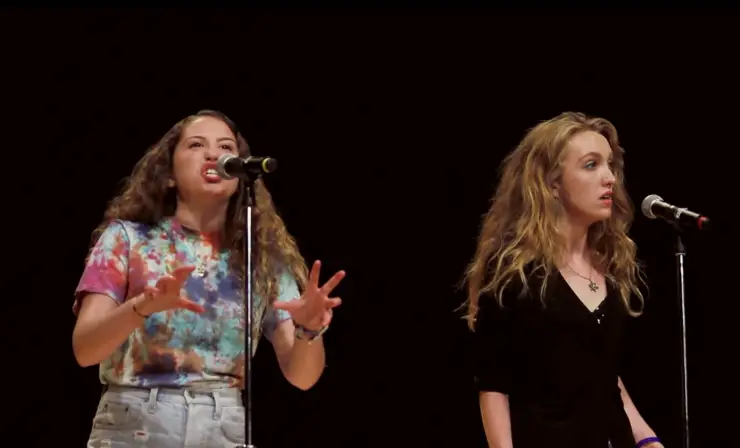
Slam poetry, an expressive form of spoken word performance, has become a captivating choice for middle school talent shows. Unlike traditional poetry, slam pieces are written to be performed, making them powerful tools for young voices eager to convey their emotions, stories, and perspectives. The rhythmic cadence, poignant themes, and personal touch that slam poets bring can resonate deeply with audiences, leaving an indelible impact.
For students keen on reciting slam poetry, here are some tips to enhance your performance:
- Embrace Your Emotions: The strength of slam poetry lies in its raw emotion. Don’t shy away from channeling your true feelings into your words. It makes your piece genuine and relatable.
- Practice Your Pace: Rhythm is crucial. Rehearse your poem multiple times to get a feel for where to slow down for emphasis and where to pick up the pace for intensity.
- Engage Your Audience: Make eye contact, use gestures, and move around the stage. Engaging your audience visually adds a layer of connection beyond just the words.
- Edit for Clarity: While your piece may be deeply personal, ensure it’s also clear and understandable for your audience. Refine your lines for maximum impact and clarity.
By mastering the art of slam poetry, students can not only showcase their talent but also share a piece of themselves, fostering understanding and connection among their peers.
Take a look at this video for a glimpse of slam poetry in action:
2. Give a Whistling Performance
Difficulty Level: Low
Participants: Solo
Needed: Microphone
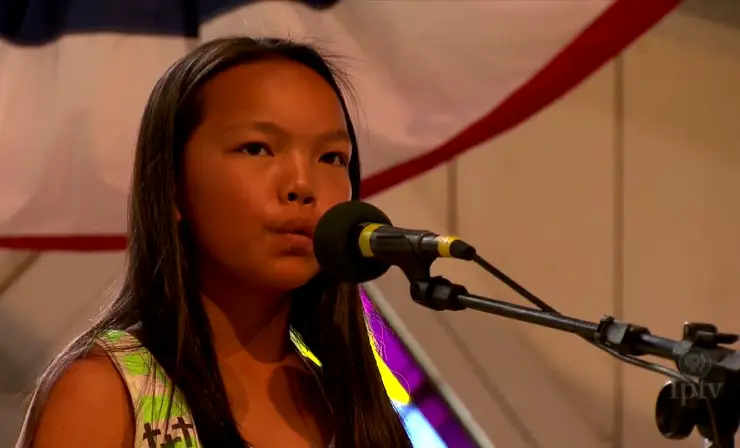
In the world of talent shows, whistling performances emerge as an unexpected and delightful surprise. While often overlooked, the art of whistling has its own nuanced techniques and variations that can captivate an audience. Middle schoolers, with their penchant for discovering and exploring new skills, can turn this seemingly simple act into a mesmerizing showcase of talent. A well-executed whistling performance can echo the melodies of popular songs, classical tunes, or even mimic nature’s symphonies, creating a memorable experience for the audience.
For students eager to dazzle with a whistling performance, consider these tips to enhance your act:
- Tune Your Technique: Just as with any instrument, mastering the basics is vital. Practice different pitches and tones to achieve a range of sounds.
- Choose the Right Song: Pick a tune that’s recognizable and fits well with the whistling medium. Melodic songs with clear and memorable tunes work best.
- Mind Your Breathing: Whistling continuously requires breath control. Practice deep breathing techniques to ensure steady airflow, and take brief pauses when necessary.
- Engage with Expression: While your mouth is busy, let your facial expressions and body language tell the story of the song, making the performance more engaging.
With dedication and practice, a whistling performance can be a standout act, demonstrating that sometimes, the most unexpected talents shine the brightest.
A good whistler can leave the audience spellbound. If you have some in your class, encourage them to perform a well-known tune or even make up a tune of their own!
Watch this video to experience a captivating whistling performance:
3. Twirl a Yo-Yo
Difficulty Level: Low to Medium
Participants: Solo
Needed: Yo-yo
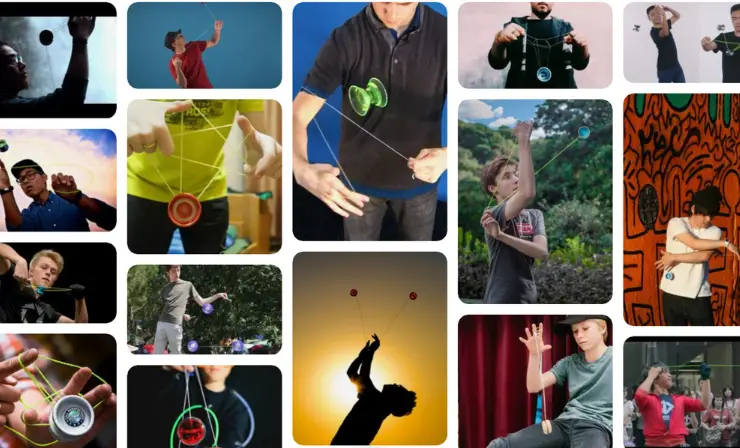
The yo-yo, though often seen as a simple toy, transforms into a mesmerizing instrument in the hands of a skilled enthusiast. As a middle school talent show idea, yo-yo tricks can be an unexpected yet thrilling performance, demonstrating both technical prowess and artistic flair. With rapid spins, around-the-world throws, and intricate string manipulations, a yo-yo artist can captivate an audience from start to finish. The ebb and flow of the yo-yo, combined with the performer’s choreographed movements, makes for a visually stunning display that stands out from more traditional acts.
For students aiming to impress with a yo-yo performance, here are some tips to refine your act:
- Master the Basics: Before diving into complex tricks, ensure you’ve perfected the basics like ‘Sleeping’, ‘Walk the Dog’, and ‘Breakaway’. A solid foundation makes advanced tricks smoother.
- Add Some Flair: Integrate some rhythmic movements or dance steps to accompany your tricks. This elevates the performance from a simple demonstration to an entertaining show.
- Plan Your Routine: Sequence your tricks in an order that builds excitement, starting with simpler moves and climaxing with your most challenging stunts.
- Ensure Equipment Maintenance: Before performing, check your yo-yo’s string for wear and ensure it’s adequately wound. A well-maintained yo-yo ensures a smoother performance.
A well-executed yo-yo performance showcases not only skill but also creativity, proving that old-school toys can still steal the spotlight.
Dive into this video to witness an impressive yo-yo showcase:
4. Emulate Classic Mime Acts
Difficulty Level: Low to Medium
Participants: Solo or Group
Needed: Mime outfits, face paint
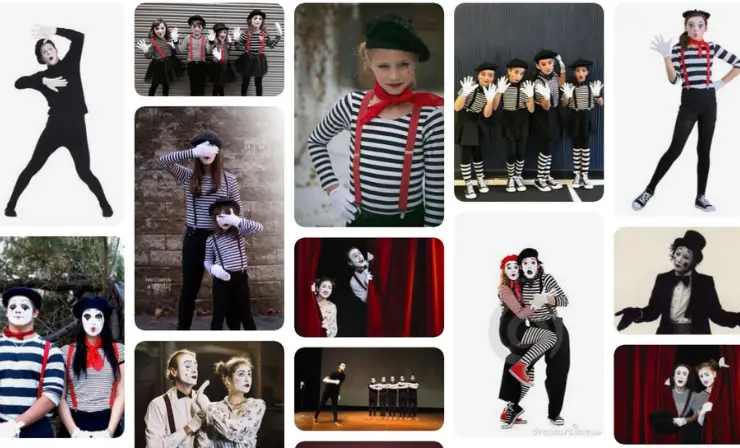
Miming, the art of storytelling through silence and movement, can be a powerful and enthralling choice for a middle school talent show. Without uttering a word, miming invites the audience into a world crafted solely by gestures, expressions, and physical theater. Whether it’s portraying the struggle against an invisible wind, climbing an unseen ladder, or being trapped in an imaginary box, the mime weaves tales that are universally understood. Such performances can evoke laughter, sympathy, or sheer wonder, highlighting the performer’s ability to communicate profound ideas without speech.
For aspiring mime artists, consider these tips to perfect your act:
- Prioritize Clarity: Every gesture should be exaggerated and deliberate. The clearer your movements, the easier it is for the audience to follow and understand your narrative.
- Perfect Your Facial Expressions: Your face is a vital tool in miming. Whether it’s a frown, a smile, or a look of surprise, ensure your expressions match and amplify your actions.
- Rehearse in Front of a Mirror: This helps you notice any inconsistencies in your movements and refine your performance for the audience’s perspective.
- Stay in Character: From the moment you step on stage until your final bow, maintain the illusion. Avoid breaking character or letting external distractions affect your performance.
When executed with passion and precision, a miming act offers a timeless display of storytelling that can mesmerize an audience, making it an exceptional talent show selection.
Explore this video to catch a mesmerizing mime act in action:
5. Drop Some Rap Verses
Difficulty Level: Low to Medium
Participants: Solo or Group
Needed: Microphone, backing track
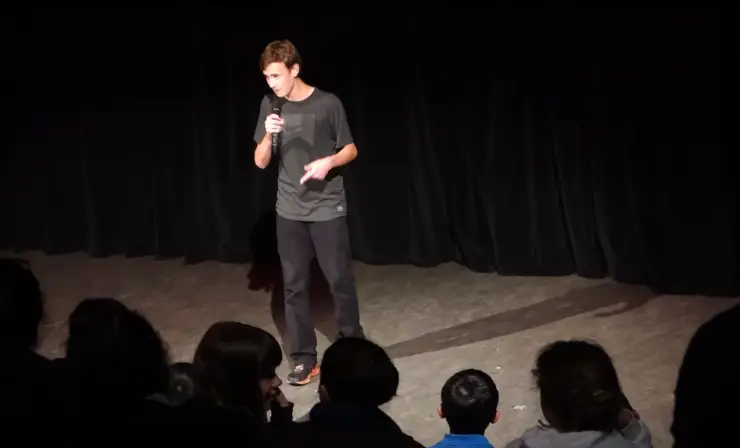
Rapping, with its rhythm-driven lyrics and energetic delivery, presents a dynamic and modern choice for a middle school talent show. A departure from traditional song performances, rapping allows students to blend lyrical poetry with beats, showcasing both creativity and musicality. It can be a platform for self-expression, where personal stories, societal observations, or imaginative tales come to life through sharp wordplay and rhythm. The pulsating beats coupled with the performer’s passion can electrify the audience, making it a memorable act that resonates with both peers and adults.
For budding young rappers, here are some tips to ensure a captivating performance:
- Write with Authenticity: Whether you’re rapping about school life, personal experiences, or fictional tales, ensure your lyrics resonate with genuine emotion and truth. Authenticity always shines through.
- Practice Your Flow: A rap’s rhythm and cadence are crucial. Repeatedly practice your verses, ensuring your delivery aligns seamlessly with the beat.
- Engage the Audience: Make eye contact, use hand gestures, and move with confidence. Your physical presence can amplify your lyrics and draw the audience into your narrative.
- Ensure Clear Enunciation: With rap’s rapid pace, clear pronunciation is essential. Make sure every word is heard and understood.
Rapping in a talent show can be both bold and refreshing, offering a unique blend of storytelling and musical prowess that’s bound to leave a lasting impression.
Watch this video to get a taste of a dynamic rap performance:
6. Deliver Stand-up Comedy
Difficulty Level: Medium
Participants: Solo
Needed: Microphone, possibly a stand
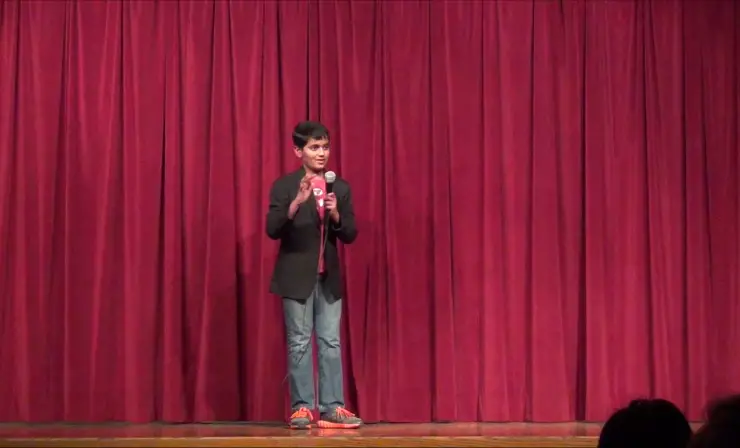
Stand-up comedy, the art of making people laugh through clever narratives and witty observations, can be a delightful addition to a middle school talent show. While many talent show acts spotlight musical or physical prowess, stand-up comedy shines a light on verbal dexterity and the ability to perceive humor in everyday situations. For middle schoolers, this can be a unique avenue to share their amusing take on school life, friendships, family, or even the quirks of growing up. The genuine laughter and engagement from the audience provide an unparalleled sense of accomplishment for the young comedian.
For students eager to venture into stand-up comedy, consider these essential tips:
- Know Your Audience: Tailor your jokes to be relatable to your middle school peers and teachers. Familiar contexts and situations can elicit the best reactions.
- Practice, Practice, Practice: Rehearse your routine multiple times to refine timing, delivery, and comedic pauses. Comedy often lies in the “how” rather than the “what.”
- Stay Confident, Even if a Joke Misses: Every comedian has moments where a joke doesn’t land as expected. Keep your confidence, move on gracefully, and don’t let it rattle you.
- Keep It Clean: Ensure your content is appropriate for a school setting. Avoid controversial topics and aim for light-hearted, fun narratives.
Stand-up comedy offers students a chance to highlight a different kind of talent, proving that sometimes laughter truly is the best entertainment.
Take a peek at this video for a snippet of stand-up comedy brilliance:
7. Unveil Mind Reading Skills
Difficulty Level: Medium
Participants: Solo
Needed: Volunteer from the audience, possible props
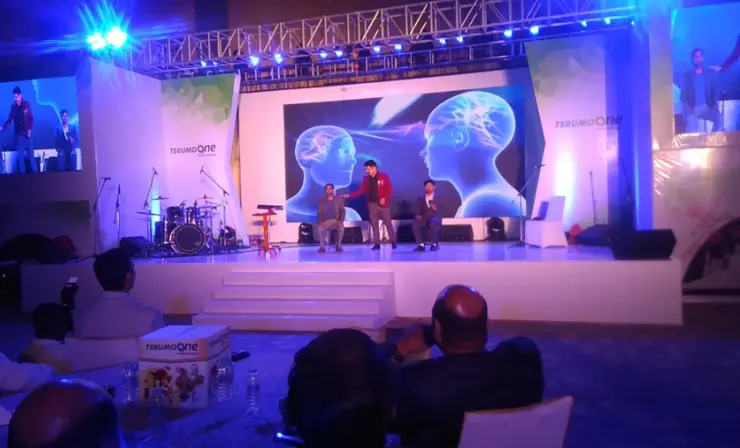
Mind reading, the art of delving into the deepest thoughts and secrets of others, can be an entrancing act for a middle school talent show. While true mind reading requires extensive study and dedication, a clever workaround can offer an equally enchanting performance. By planting a few confidants in the audience, your child can create the illusion of tapping into their thoughts, leaving spectators in awe. With the right presentation techniques and some personalized flair, the act can seamlessly blend magic with theater, making your child seem as mysterious as a seasoned psychic.
For young illusionists aiming to mesmerize with a mind reading act, consider these crucial tips:
- Preparation is Key: Coordinate with your planted audience members in advance. Plan out the questions and the answers to ensure a smooth flow during the act.
- Craft a Compelling Persona: Don a mystical costume, use a captivating tone, and maintain a mysterious demeanor throughout the performance to enhance the illusion.
- Diversify Your ‘Readings’: While having planted participants is essential, throw in some general readings that can resonate with anyone, adding an extra layer of believability.
- Engage with the Audience: Make regular eye contact, ask open-ended questions, and respond to reactions. This helps build rapport and maintain the illusion’s credibility.
With the right approach, a mind reading act can become the talk of the talent show, offering a blend of mystique and entertainment.
View this video to experience an intriguing mind-reading act:
8. Spin as a DJ
Difficulty Level: Medium
Participants: Solo
Needed: DJ equipment, speakers
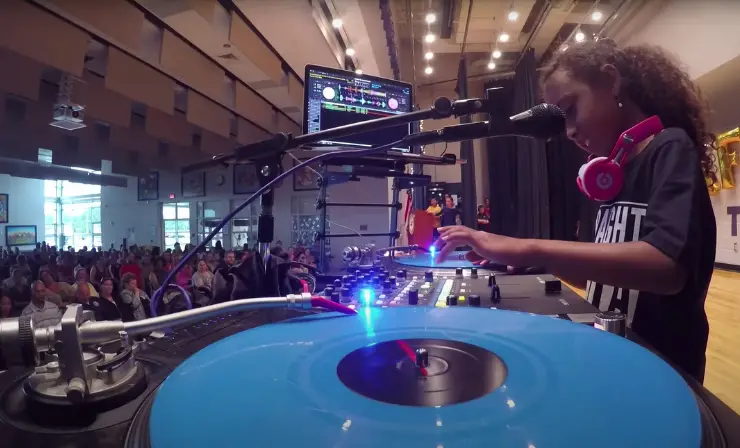
DJing, the craft of mixing and blending music to create electrifying soundscapes, stands out as a modern and exhilarating option for a middle school talent show. In an era where electronic music is increasingly influential, a young DJ can tap into this trend, turning the school stage into a pulsating mini-concert. Using a combination of beats, melodies, and rhythmic transitions, a DJ act can uplift the energy of the room, making spectators sway, tap their feet, or even dance. This act not only showcases technical prowess but also the DJ’s unique taste and style.
For budding DJs eager to make a mark, consider these essential tips:
- Know Your Audience: Curate a setlist that resonates with your peers. Mix popular tracks with some unexpected gems to keep the audience engaged and excited.
- Practice Transitions: Smooth transitions between tracks are the hallmark of a skilled DJ. Spend ample time perfecting your blending techniques to ensure a seamless flow.
- Engage with Energy: Your enthusiasm is infectious. Use body language, maintain eye contact, and occasionally hype up the crowd to keep the energy levels high.
- Check Your Equipment: Before the performance, ensure all your gear—mixer, headphones, laptop, and speakers—is in top working condition to avoid technical glitches.
A well-executed DJ act can introduce a fresh, contemporary vibe to the talent show, emphasizing the evolving nature of artistic expression among the youth.
Tune into this video to witness a DJ set in full swing:
9. Impress with Beatboxing
Difficulty Level: Medium
Participants: Solo
Needed: Microphone
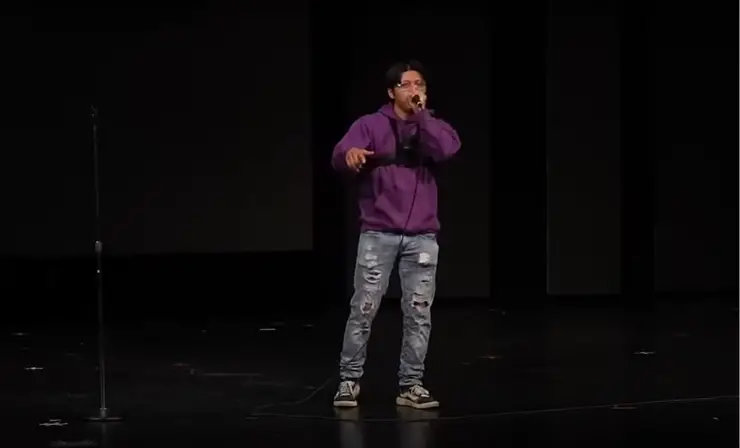
Beatboxing, the incredible art of producing drum beats, rhythms, and musical sounds using one’s mouth, voice, and throat, is a captivating choice for a middle school talent show. Emerging from the heart of hip-hop culture, beatboxing allows for a raw, powerful performance without the need for any instruments. A young beatboxer, armed only with their vocal prowess, can transform the stage into a musical arena, creating beats that reverberate with energy and creativity. It’s a mesmerizing display of vocal dexterity that leaves audiences in awe.
For budding beatboxers keen on showcasing their skills, here are some essential tips:
- Master the Basics: Before delving into complex beats, ensure you have a solid grasp on foundational sounds like the kick drum, hi-hat, and snare. These are the building blocks of any beatboxing routine.
- Stay Hydrated: Beatboxing can be taxing on the vocal cords. Drink plenty of water before and during your performance to keep your throat lubricated and sounds crisp.
- Experiment with Variations: While replicating popular beats can be impressive, adding your unique twist or creating original rhythms can set you apart.
- Engage the Audience: Make eye contact, move to your beats, and involve the audience in a call-and-response if possible. Interaction amplifies the energy of your performance.
Embracing beatboxing in a talent show can be both innovative and enthralling, emphasizing the diverse range of talents among today’s youth.
Dive into this video to catch the rhythm of a beatboxing showcase:
10. Showcase Pet Tricks
Difficulty Level: Medium
Participants: Solo (and pet)
Needed: Pet, treats, and any necessary props
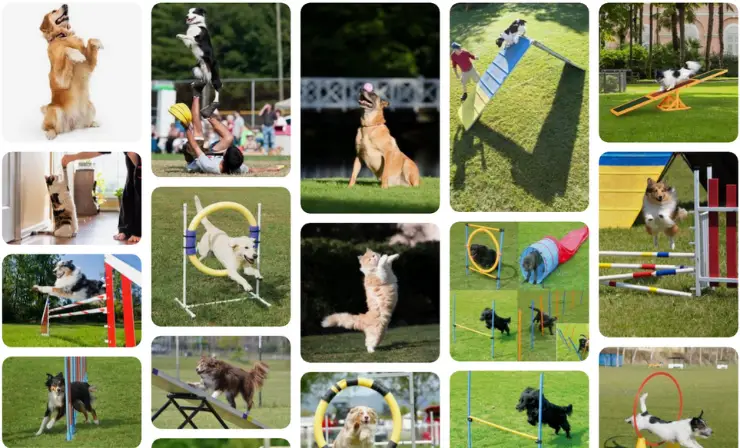
In the colorful realm of talent shows, showcasing pet tricks offers a delightful and unexpected twist. These acts, filled with adorable antics and impressive commands, allow students to spotlight the bond they share with their furry, feathered, or even scaled companions. Whether it’s a dog performing a series of intricate jumps, a parrot mimicking phrases, or a cat navigating an obstacle course, pet tricks celebrate the wonder of animal intelligence and their connection with humans. An engaging pet act can melt hearts, ignite laughter, and earn a resounding round of applause from an enchanted audience.
For those considering showcasing their pet’s talents, here are some vital tips:
- Rehearse in Varied Environments: To ensure your pet is comfortable on stage, practice tricks in different surroundings, gradually introducing them to noisier and unfamiliar spaces.
- Prioritize Safety: Always ensure the safety of both your pet and the audience. Use leashes, barriers, or enclosures as needed.
- Offer Positive Reinforcement: Reward your pet with treats, praises, or affection after they perform a trick. Positive reinforcement encourages consistency in their performance.
- Keep it Short and Sweet: Animals can get overwhelmed. Plan a concise routine that highlights their best tricks without overstressing them.
Featuring pet tricks at a middle school talent show provides a unique and heartwarming performance, emphasizing the diverse talents that exist beyond the classroom.
Watch this video to explore how performing pet tricks can be a show-stopping talent show act:
11. Lead a Cheerleading Routine
Difficulty Level: Medium
Participants: Group
Needed: Uniforms, pom-poms, music
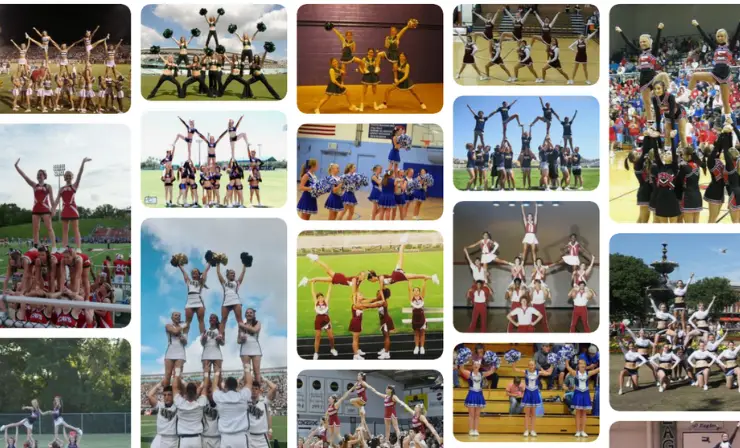
Cheerleading, often associated with sports games and pep rallies, makes for an electrifying middle school talent show act. With its dynamic blend of dance, stunts, and chants, cheerleading is more than just waving pom-poms; it’s a display of coordination, strength, and spirit. A well-executed cheerleading routine can uplift the energy in the room, showcasing team synchronization and individual acrobatics in a vibrant spectacle. When set to catchy music, peppered with high-flying jumps and precise formations, it becomes an act that’s both visually and audibly compelling, drawing applause from the most reserved of audiences.
For squads gearing up to bring cheerleading to the talent stage, here are some pointers:
- Prioritize Safety: Stunts and tumbling require precision and practice. Always ensure your squad practices safely, using mats if necessary, and considering a spotter for complex stunts.
- Sync with the Music: Choose upbeat tracks that complement your routine, ensuring that every move aligns with the beat for maximum impact.
- Showcase Diversity: Blend a mix of formations, dance segments, jumps, and chants to keep the audience engaged from start to finish.
- Project Enthusiasm: Cheerleading is as much about spirit as it is about skills. Smile, maintain energy, and ensure your chants are loud and clear.
Cheerleading, when introduced in a talent show context, underscores the importance of teamwork and the exhilarating heights it can achieve.
Take a look at this video to experience the energy of a cheerleading routine:
12. Nail Basketball Tricks
Difficulty Level: Medium
Participants: Solo or Group
Needed: Basketball, hoop
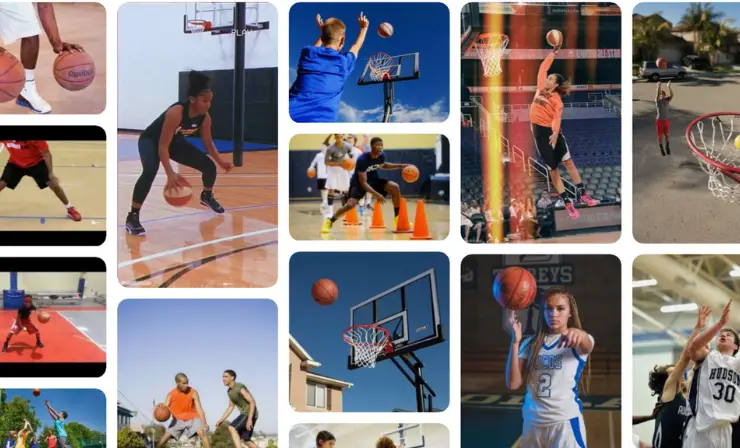
Basketball, typically seen lighting up courts and sports arenas, can take center stage in a whole new way when showcased as a talent show act. Basketball tricks blend the finesse of dribbling, shooting, and juggling, turning the sport into a rhythmic and entertaining dance of agility. Whether it’s intricate ball-handling routines, spinning the ball on one’s finger, or executing no-look passes and shots, these tricks captivate audiences with their unpredictability and flair. It’s a refreshing talent show idea that marries athleticism with showmanship, offering a sporty alternative to the usual acts.
For those eager to dazzle with basketball tricks, consider these tips:
- Sequence Matters: Organize your routine so that it flows smoothly from one trick to the next. Start with simpler tricks and gradually build up to your most impressive feats for a climactic finish.
- Engage the Crowd: Make your performance interactive by involving the audience. This could be through direct participation, call-and-response chants, or simply maintaining eye contact during key moments.
- Ensure Proper Equipment: Use a well-inflated basketball and wear appropriate shoes for grip. If possible, rehearse on the same floor type you’ll perform on.
- Practice Consistency: While every trick might not land perfectly every time, regular practice ensures a smoother and more confident performance.
Basketball tricks in a talent show spotlight the elegance of sports skills, offering a dynamic and athletic dimension to the event.
Watch this video to witness the flair of basketball tricks tailored for a talent show spotlight:
13. Dramatize through Acting
Difficulty Level: Medium
Participants: Solo or Group
Needed: Script, costumes, possibly props
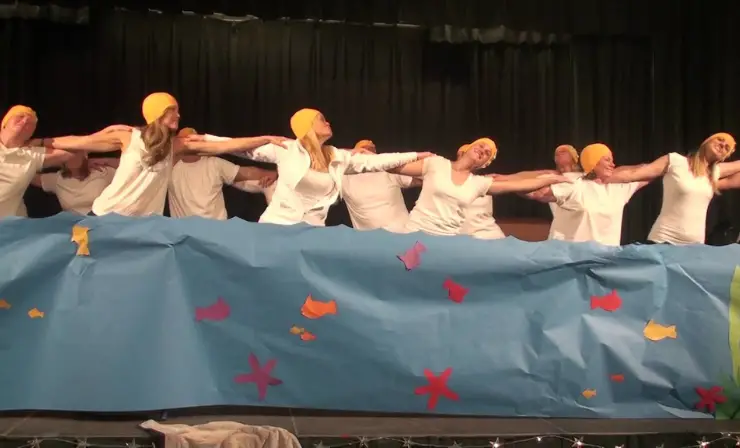
When considering talent show acts, acting offers a profound and impactful avenue for students to explore. Transporting the audience to different worlds through dialogue, emotion, and character, acting can be as riveting as any song or dance number. Whether it’s a heartfelt monologue, a gripping scene from a popular play, or a comedic skit written by the students themselves, acting is a testament to the power of storytelling and human connection. In a talent show context, it provides a refreshing pause from the usual musical and dance performances, allowing the audience to immerse in narratives and characters.
For young thespians ready to steal the spotlight, here are some essential acting tips:
- Character Development: Invest time in understanding the motivations, quirks, and emotions of the character. This depth brings authenticity to the performance.
- Rehearse Regularly: Whether it’s a solo act or a group scene, consistent practice refines dialogue delivery, facial expressions, and body language.
- Engage with the Audience: Acting is as much about the receiver as the performer. Make eye contact, project your voice, and be mindful of your stage presence to captivate viewers.
- Embrace Feedback: Before the main show, perform in front of friends or family and gather feedback. This helps fine-tune the act.
Acting, when introduced to the talent show stage, illuminates the timeless charm of drama and the versatility of young talents. Unsure about your performance choice? Explore our article on musicals for some inspiration.
Dive into this video to catch a glimpse of a compelling acting skit in action:
14. Glide on Roller Skates
Difficulty Level: Medium
Participants: Solo or Group
Needed: Roller skates, protective gear
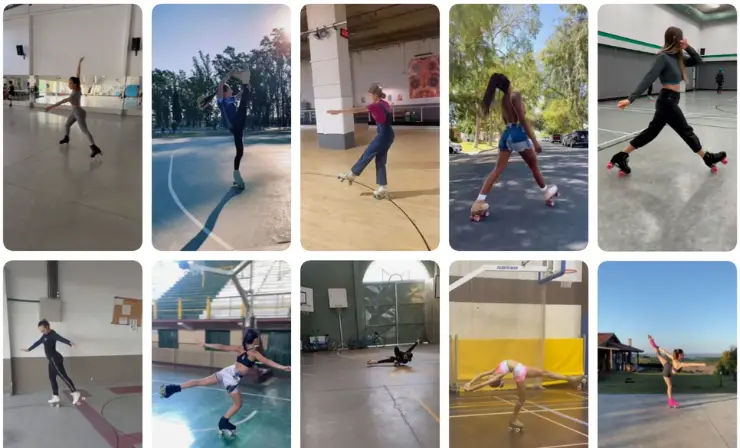
Rollerskating, with its graceful twirls and speedy spins, can add a dynamic touch to any middle school talent show. Evoking nostalgia while being refreshingly modern, a rollerskating act combines athleticism with artistry. Whether it’s a choreographed dance to a popular tune, a series of intricate tricks, or simply a demonstration of speed and control, rollerskating can mesmerize spectators as performers glide, whirl, and jump across the stage. The fluidity and elegance of movement, punctuated by the occasional daredevil stunt, offer a unique blend of dance and sport that’s sure to captivate.
For students eager to roll into the spotlight, here are some essential rollerskating tips:
- Safety First: Always wear protective gear during rehearsals and performances. Helmets, knee pads, and elbow pads can prevent unnecessary injuries.
- Choose the Right Skates: Ensure the skates fit well and are appropriate for the chosen routine, whether they are quad skates or inline skates.
- Smooth Surface: The performance area should be free of debris and obstructions. If possible, practice on the actual stage to get accustomed to its surface.
- Connect with the Music: If performing a choreographed routine, choose music that resonates and practice syncing each move to the rhythm and beats.
Incorporating rollerskating into a talent show provides a refreshing, kinetic performance, showcasing a beautiful synthesis of balance, speed, and rhythm.
Take a look at this video to witness a demonstration of rollerskating as an engaging talent show idea:
15. Ride a Unicycle with Flair
Difficulty Level: Medium
Participants: Solo or Group
Needed: Unicycle, protective gear
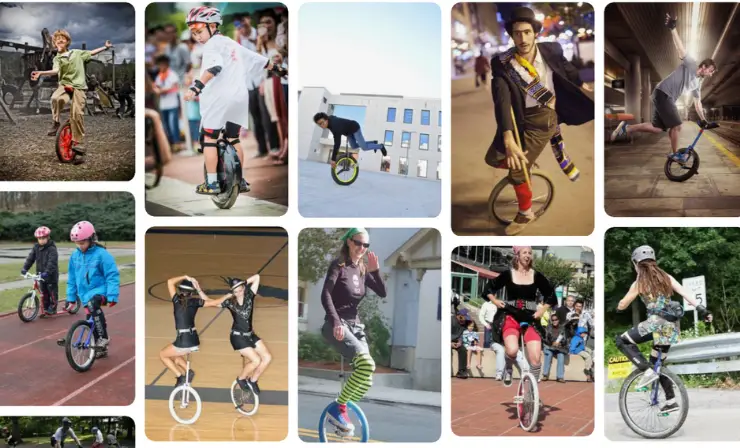
Riding a unicycle, often seen as a staple in circus acts, can be a standout feature in a middle school talent show. This singular wheel demands balance, concentration, and skill, making it a thrilling watch for audiences of all ages. A unicycle performance could range from a straightforward demonstration of riding skills to intricate routines involving tricks, jumps, and even juggling while atop the unicycle. The sheer challenge of maintaining equilibrium on one wheel, combined with the elegance and audacity of the rider, makes for a spellbinding spectacle.
For middle schoolers eager to take center stage on a unicycle, here are some guiding tips:
- Safety Comes First: Especially for beginners, protective gear like helmets, knee pads, and wrist guards are essential. They not only safeguard the rider but can also boost confidence during the performance.
- Pick the Right Size: Ensure the unicycle’s size matches the rider’s height and leg length for optimal control and comfort.
- Start Simple: For those new to unicycling, start with basic riding and gradually incorporate tricks as skills improve. Mastery of simple tasks can be just as impressive as complex stunts.
- Engage the Audience: Interact with spectators, make eye contact, and perhaps even include comedic elements to make the act memorable.
Showcasing unicycling in a talent show underscores the incredible capabilities of young performers, combining athleticism with artistry in a unique display of balance and precision.
Watch this video to observe a demonstration of riding a unicycle:
16. Master Juggling
Difficulty Level: Medium to High
Participants: Solo
Needed: Juggling balls or pins
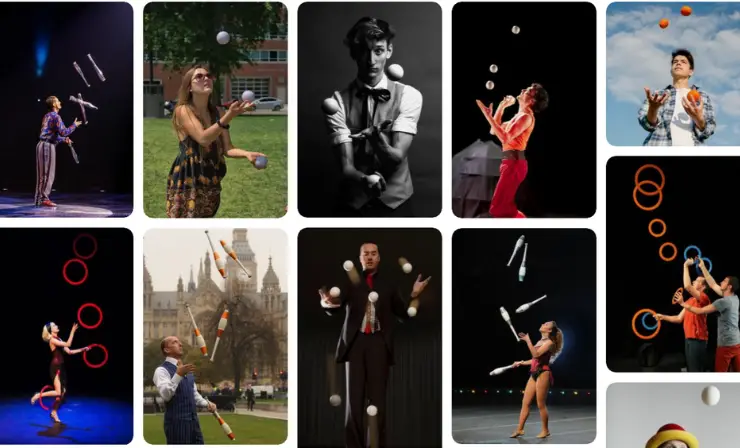
The age-old art of juggling never ceases to amaze, and in a middle school talent show setting, it shines brilliantly. Juggling requires dexterity, concentration, and timing, and when executed flawlessly, the flying objects, whether balls, clubs, or even rings, create a hypnotic dance in mid-air. For the audience, there’s a sense of suspense and wonderment, watching each object being thrown and caught in rhythm. Whether it’s a classic three-ball cascade or more advanced patterns and props, juggling provides a visual feast that’s both entertaining and awe-inspiring.
For budding jugglers aiming to impress, here are some key pointers:
- Start Small: Before diving into complicated patterns, master the basics. A seamless three-object juggle can be as captivating as juggling more items.
- Choose the Right Props: Beginners might find bean bags or soft balls easier to handle, as they don’t bounce away when dropped. As confidence grows, experiment with clubs, rings, or even flaming torches (with proper safety measures!).
- Maintain Focus: While juggling, it’s crucial to keep your eyes on the highest point of the thrown object’s arc, not on your hands.
- Engage and Interact: To elevate the performance, incorporate elements of humor, surprise, or even invite an audience member for a simple catch.
Juggling, as a talent show act, embodies the perfect blend of skill and showmanship, leaving audiences both entertained and inspired by the marvels of human coordination.
Explore this video to witness an illustration of juggling as an engaging talent show idea:
17. Demonstrate a STEM Concept
Difficulty Level: Medium to High
Participants: Solo or Group
Needed: Relevant materials and equipment for the demonstration
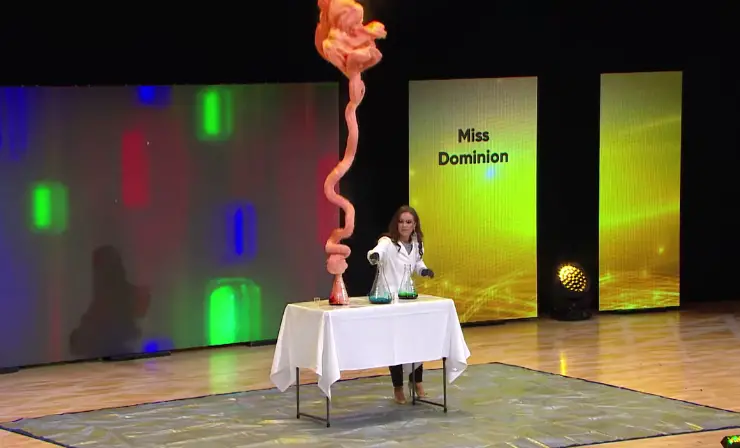
STEM (Science, Technology, Engineering, and Math) brings a refreshing and educational dimension to middle school talent shows. While talent shows often focus on artistic and performance skills, a STEM act can dazzle the audience with fascinating experiments, robotic displays, or even intricate mathematical solutions visualized in real-time. Think of a live volcano eruption demonstration, a mini robot dance, or a mesmerizing mathematical magic trick. These activities not only entertain but also ignite curiosity and promote learning. By integrating STEM, students showcase their analytical prowess, creativity, and innovation, all under the spotlight.
For students keen on bringing STEM to the stage, consider these guidelines:
- Safety First: If experiments are involved, especially chemical reactions, ensure all safety protocols are in place. This includes wearing safety goggles, gloves, and having a first-aid kit on standby.
- Engage the Audience: Simplify complex concepts for better understanding. Pose questions, create suspense, or even involve a volunteer to make the presentation more interactive.
- Rehearse Thoroughly: Whether it’s a demonstration or a robotic act, make sure everything works smoothly. Practice to ensure timings, transitions, and explanations are on point.
- Visual Appeal: Use props, colorful visuals, or digital displays to make the activity more aesthetically pleasing and captivating.
Incorporating STEM into talent shows not only diversifies the event but also underscores the beauty of intellectual exploration and the wonders of science and technology.
Camille Schrier won Miss America 2020 with a STEM demonstration! Need some ideas for experiments and demos? Check out our STEM experiments article.
View this video to witness a demonstration of performing STEM experiments:
18. Accelerate with Speed Painting
Difficulty Level: High
Participants: Solo
Needed: Canvas, paints, brushes
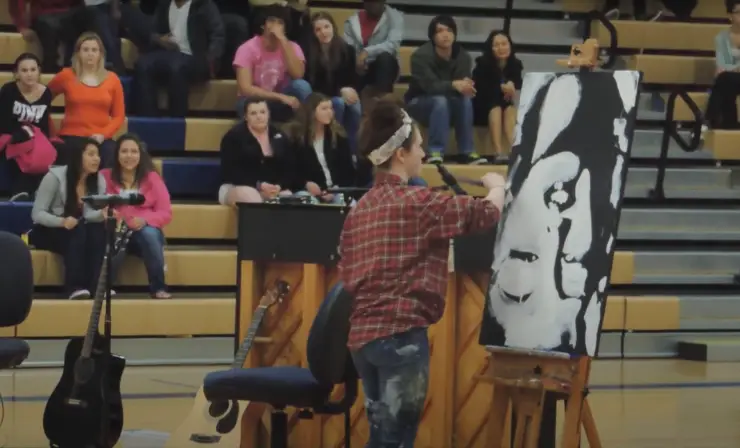
Speed painting takes the classic art of painting and transforms it into a dynamic performance art, making it a captivating choice for a middle school talent show. Within a limited timeframe, artists rapidly create a piece, layering colors, and shapes in a flurry of motion. The beauty of speed painting is twofold: the process itself, with its rapid strokes and splashes, and the final artwork that emerges seemingly out of chaos. Whether it’s a portrait, a landscape, or an abstract piece, the rapid creation of art in real-time is both thrilling and mesmerizing for audiences.
For students eager to paint against the clock, here are some tips for a successful speed painting act:
- Preparation is Key: Have all your materials—brushes, paints, canvas—set up and within easy reach. Time lost searching for a brush can disrupt your flow.
- Practice the Sequence: Know the progression of your artwork. Rehearse multiple times to refine the sequence of strokes, ensuring a smooth and timely completion.
- Engage the Audience: Use dramatic pauses, interact with onlookers, or even synchronize your painting process to music to enhance the entertainment factor.
- Highlight the Reveal: Build anticipation for the final artwork. Consider starting with abstract forms that only become clear towards the end for a dramatic reveal.
Incorporating speed painting into talent shows provides a vivid splash of creativity, showcasing the intersection of artistry, performance, and time management.
Watch this video to witness an example of speed painting in action:
19. Assemble a Band
Difficulty Level: High
Participants: Group
Needed: Instruments, amplifiers, music
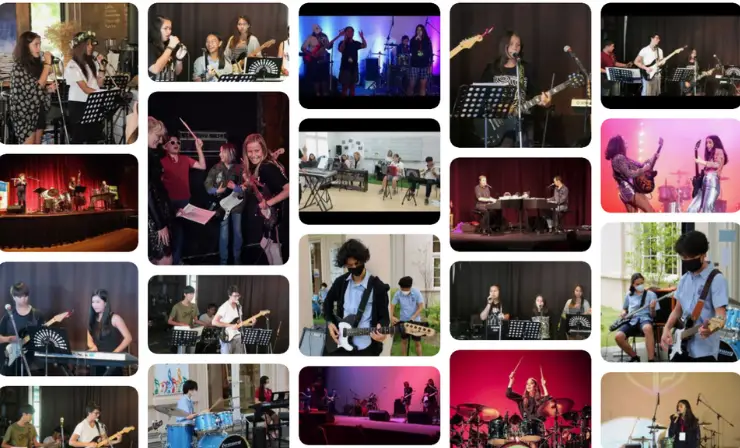
Nothing quite matches the electrifying energy of a live band performance. In a middle school talent show, a band can elevate the atmosphere, engaging audiences with a harmonious blend of vocals, instruments, and rhythm. From chart-topping hits to soulful originals or even a twist on classical tunes, a band showcases teamwork, musical talent, and creativity all at once. Whether it’s a rock ensemble with electric guitars and drums or an acoustic set with soft vocals and ukuleles, the pulsating rhythms and melodies resonate, making for a memorable showstopper.
For young musicians ready to rock the stage, here are some vital tips:
- Rehearse Relentlessly: A band is a sum of its parts. Regular practice ensures synchronization, clear vocals, and flawless instrumentals. Remember, consistency is key.
- Sound Check: Prior to the performance, make time for a sound check. Balance the levels of each instrument and microphone to ensure clarity and prevent feedback.
- Engage the Audience: Connect with the audience through eye contact, brief interactions, or encouraging claps and sing-alongs. Make them a part of the performance.
- Plan Transitions: If performing multiple songs or segments, ensure smooth transitions. This helps maintain the flow and keeps the audience hooked.
A band performance in a talent show encapsulates the spirit of collaboration, passion, and musical flair, leaving audiences tapping their feet and humming along long after the curtains fall.
Tune into this video to experience a live band performance at a talent show:
20. Choreograph Dancing Drones
Difficulty Level: High
Participants: Solo or Group
Needed: Drones, remote controls, music
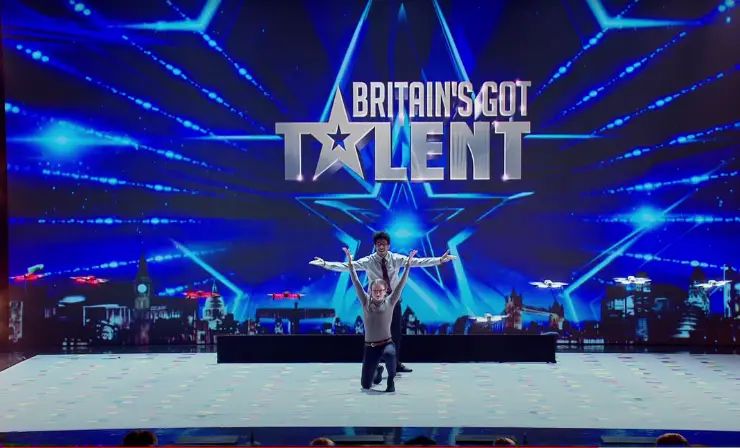
Incorporating technology with traditional arts creates mesmerizing performances, and dancing with drones epitomizes this blend. As a talent show idea, dancing with drones brings forth a harmonious ballet of human grace and precision robotic flight. The drones, equipped with lights and choreographed to move in sync with the dancer, weave an enchanting narrative in the air. The synchronization of the dancer’s fluid movements with the aerial acrobatics of the drones adds layers of depth and magic to the performance, promising a spectacle like no other.
For students wishing to merge dance and drones, these tips can guide the way:
- Safety First: Always ensure that the drones are in perfect working condition and are calibrated correctly. Designate a safe space for the performance, away from spectators.
- Choreograph Precisely: Both the dancer and the drones must be in perfect sync. This requires meticulous choreography, practice, and perhaps even software assistance for drone movements.
- Light It Up: Drones can be equipped with LED lights. Use this to create captivating visual effects, especially if the performance is in dim light or darkness.
- Music Selection: Choose a piece of music that complements the futuristic vibe. This can enhance the audience’s immersion in the performance.
Blending technology with dance in middle school talent shows offers a glimpse into the future of performance arts, where tradition and innovation coalesce in breathtaking displays.
Witness a captivating dancing with drones performance at a talent show by watching this video:
21. Enthrall with a Circus Act
Difficulty Level: High
Participants: Solo or Group
Needed: Props specific to the act (e.g., balance board, hoops)
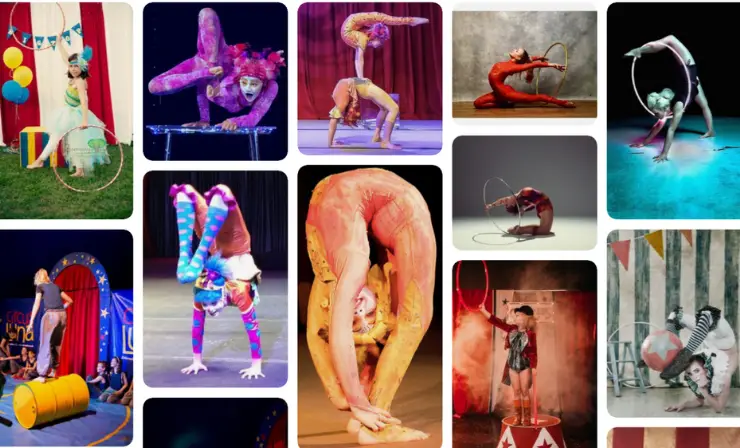
A circus act, with its whimsical charm and thrilling feats, can be the highlight of any middle school talent show. Traditionally synonymous with grand tents and a plethora of performers, the essence of a circus can be distilled into smaller acts perfect for a school stage. Think of a daring juggling routine, humorous clown antics, acrobatics, or even a magical plate-spinning display. These acts capture the essence of wonder, risk, and sheer entertainment, evoking awe from an audience of peers and teachers alike.
For students eager to channel their inner circus performer, here are some golden guidelines:
- Prioritize Safety: Regardless of the act, always prioritize safety. For acts that involve acrobatics or balancing, ensure the presence of safety mats and spotters.
- Rehearse to Perfection: Circus acts require precision. Repeated practice helps in refining movements, ensuring synchronization, and building confidence for the final performance.
- Engage with Theatrics: Enhance your act with costumes, makeup, and props. A circus is as much about the visual spectacle as it is about the skill.
- Involve the Audience: Engage the audience with direct eye contact, playful banter, or even pulling a willing participant on stage for a simple trick.
By introducing a circus act into a middle school talent show, performers transport audiences into a world of wonder, leaving them enchanted with a mix of skill, drama, and delightful surprises.
View this video to witness an exemplary circus act in action:
Organizing a School Talent Show in 6 Steps
Organizing a top-notch talent show requires effort, yet the joy and pride on the students’ faces, receiving applause from their peers, make it a rewarding endeavor. Here are aspects to consider as you gear up for the event.
Step 1: Decide the Format
Firstly, determine if your show will purely showcase talents or if it will be a competitive contest. Both options have their merits, so your choice will hinge on your preference for planning intricacy. Should you opt for a contest format, you’ll need to arrange for judges, prizes, and possibly categorize the acts.
Step 2: Set the Date
Consider scheduling your show within school hours to ensure maximum student participation. Relying on after-school slots can exclude some students due to parental constraints. Keep in mind, the event can be livestreamed or recorded for later viewing by parents and friends.
Step 3: Appoint Host and Judges
Choose a dynamic host, possibly a school principal or spirited student, to effectively introduce acts and ensure smooth transitions. If you’re judging the talent, select impartial judges, excluding parents of participants for fairness. Think about inviting a local celebrity for added excitement. Implement a structured scoring system for judges to facilitate decision-making at the show’s conclusion.
Step 4: Choose the Venue

Select a suitable location for your talent show, be it the school auditorium, gymnasium, or outdoors. While an auditorium offers sound systems and theatrical elements like curtains and lighting, open spaces like gymnasiums provide versatility, allowing acts like basketball trick shots or skateboard stunts.
Step 5: Conduct Auditions
Holding auditions is recommended, even if all interested students are allowed to perform. Auditions help gauge the variety of acts, filter out unsuitable ones, determine equipment needs, and estimate the event’s duration.
Step 6: Revel in the Event

On the talent show day, arrive ahead of time to manage setup and last-minute preparations, guaranteeing performers are organized and prepped backstage. As the show commences, immerse yourself in the performances alongside the audience, staying alert for unforeseen challenges, ensuring a seamless and delightful event for everyone.
4 Additional Talent Show Tips
- Consider distributing printed programs detailing performers and acts as mementos.
- If it’s a contest, acknowledge all participants with certificates or tokens of appreciation.
- Encourage diverse talents. For acts that require close-up views, utilize projections or recorded videos.
- Ensure acts are clean and don’t create a mess. Ensure participants are responsible for their setups and cleanup, promoting a safe environment for subsequent performers.
Useful Resources
- Talent Show Judging Criteria
- Talent Show Rules & Regulations
- How To Stage a Successful School Talent Show by PTO Today
Conclusion
Harnessing the vibrant energy of middle schoolers, talent shows offer a platform for unparalleled creativity. Whether a fundraiser or a showcase, these 21 ideas ensure every performance is memorable. Dive in, inspire, and let the next generation of talent shine brightly in the heart of school communities.
- Overview of 22 Low-Code Agencies for MVP, Web, or Mobile App Development - October 23, 2024
- Tips to Inspire Your Young Child to Pursue a Career in Nursing - July 24, 2024
- How Parents Can Advocate for Their Children’s Journey into Forensic Nursing - July 24, 2024
